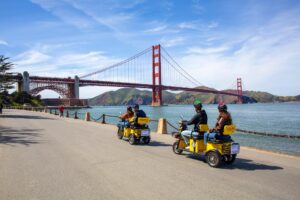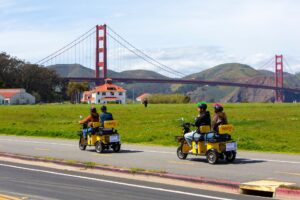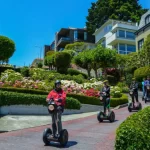Coit Tower and Telegraph Hill: A Fun Guide to one of San Francisco’s Iconic Landmarks plus some fun facts
San Francisco is a city full of iconic landmarks, but few are as recognizable as Coit Tower and Telegraph Hill. These two landmarks are located in the heart of the city and offer visitors breathtaking views, rich history, and plenty of opportunities for fun and adventure. In this blog post, we’ll explore everything you need to know about Coit Tower and Telegraph Hill, from their history and architecture to the best ways to experience them for yourself.
First, let’s talk about Coit Tower. This 210-foot-tall tower was built in 1933 as a tribute to the volunteer firefighters of San Francisco. It’s located on the top of Telegraph Hill and offers panoramic views of the city and the Bay. The tower was designed by architect Arthur Brown Jr., who also designed City Hall and the War Memorial Opera House. The tower is made of reinforced concrete and is covered in a layer of white stucco, giving it a clean, modern look.
A Tribute to a Philanthropic Firefighter Supporter
Built-in honor of wealthy socialite Lillie Hitchcock Coit, Coit Tower is made of unpainted, reinforced concrete. The tower was built in her honor after she specified that one-third of her fortune go to beautifying the city she loved. Construction on the tower began after her death in 1929 and finished in 1933. Lillie spent her life helping volunteer San Francisco firefighters. From the age of 15, when the teenage Lillie witnessed a fire engine crew in need and sprang into action, Lillie was a fervent supporter of the volunteer fire engine crews of San Francisco until her death in 1929. In her will, Lillie set aside an entire third of her fortune to go toward the beautification of the city of San Francisco that she loved. Two memorials were built in honor of her contribution to the city: Coit Tower and the firefighter sculpture in North Beach’s Washington Square. Coit Tower is the more famous of the two, nestled amongst the trees on the peak of Telegraph Hill.
One of the most unique things about Coit Tower is the artwork that adorns its walls. The tower was decorated with a series of frescoes by a group of artists who were part of the New Deal’s Public Works of Art Project. These frescoes depict scenes of San Francisco life in the 1930s and are considered some of the most important examples of public art from that era.
To experience Coit Tower for yourself, you’ll need to take a hike up Telegraph Hill. The hike is a bit of a workout, but the views from the top are worth it. Once you reach the top, you can take an elevator to the observation deck for even more breathtaking views. The tower is open every day of the week, and admission is $10 for adults and $5 for children.
Next, let’s talk about Telegraph Hill. This hill is located in the northeastern part of San Francisco and is known for its steep inclines, winding streets, and beautiful Victorian homes. The hill got its name from the telegraph station that was built on top of it in the 1850s. The station was used to communicate with ships in the Bay, and it’s said that the hill’s height made it the perfect spot for the telegraph’s signal to reach the ships.
One of the most famous residents of Telegraph Hill is a flock of wild parrots. These parrots are actually a non-native species, and it’s believed that they escaped from a pet store in the 1980s. Today, the parrots are a beloved part of the Telegraph Hill community, and you can often see them perched in the trees around the hill.
To experience Telegraph Hill for yourself, the best way is to take a walk through the neighborhood. You’ll see Victorian homes, winding streets, and plenty of greenery. You can also take a walk through Pioneer Park, which is located at the top of the hill. The park offers great views of the city and the Bay, and it’s a popular spot for picnics and relaxation.
Coit Tower and Telegraph Hill are two of San Francisco’s most iconic landmarks. They offer visitors breathtaking views, rich history, and plenty of opportunities for fun and adventure. Whether you’re interested in art, or architecture, or just want to take in the views, Coit Tower and Telegraph Hill are must-see destinations on any trip to San Francisco. Don’t forget to bring your camera, and also your hiking shoes, because you’re going to need them for this adventure!
Access to Coit Tower
Coit Tower is located on Telegraph Hill in Pioneer Park. If you are feeling adventurous or want some exercise along with your view, take the Filbert Steps from Sansome Street up to Coit Tower. The stairs are steep and pass through a series of sculpted gardens as well as past incredibly beautiful homes. The stairs end near the base of Coit Tower in Pioneer Park.
The steps on Greenwich Street are also on the backside of Telegraph Hill, closest to the water. These steps afford beautiful views of the city from a perspective few will see on their visit to San Francisco. The steps are well-maintained, and benches sit in nooks to the side for people to pause and take in the view.
Nine Fun Facts about Coit Tower
Coit Tower, sitting pretty on Telegraph Hill, is more than just a pretty view of San Fran. This iconic landmark has a rich history and some fun facts that will make you want to visit ASAP. So pack your hiking shoes, and let’s dive in!
#1 Money talks:
Coit Tower is named after Lillie Hitchcock Coit, a wealthy socialite who had a soft spot for local firefighters. When she passed, she left a third of her fortune (which is almost 2 million dollars today!) to the city with instructions that it was to be used to add beauty to the city she loved.
#2 Not a fire hose nozzle:
Coit Tower is sometimes referred to as the “Coit Memorial Tower” in honor of the volunteer firemen who lost their lives during the 5 great fires in San Francisco. Although some say it looks like a fire hose nozzle, it was not designed to look like one.
#3 Who designed it?
The same architectural firm that built San Francisco City Hall also designed Coit Tower, but the architect behind the design was Henry Howard, not Arthur J. Brown.
#4 Skinny is the new sexy:
The tower’s vertical design was chosen to make a monumental statement within the small site and budget while complementing the proportions of the hill. And that fluted look? That’s to avoid looking top-heavy. The difference in diameter at the top of the tower compared to the bottom is just 18 inches.
#5 Depression Era murals:
The interior murals were created as part of the Public Works of Art Project during the Depression era, employing out-of-work artists. They were considered incendiary at the time for their socialist overtones, but also for daring to depict people of color alongside white workers.
#6 Locked up and painted over:
During the longshoreman’s strike of 1934, the city painted over some of the more offending elements for fear that the art would stir up too much sympathy for workers. They also locked the public out of the tower to keep the murals from public view for a while.
#7 Women muralists:
There are 27 murals in total, created by 26 artists; four of which were women. The total cost of the mural project: $26,022 and was completed on budget.
#8 Don’t shoot!
Shortly after the tower opened, the owner of a Union Street cafe went up to the roof to fire a rifle at it, complaining that it “invaded the sanctity of his view.”
#9 Parrot party:
As you wander the trails that wind around the tower, you may hear the raucous chatter of the neighborhood’s most famous (and noisiest) residents, the flock of parrots featured in the 2005 film “The Wild Parrots of Telegraph Hill”.







